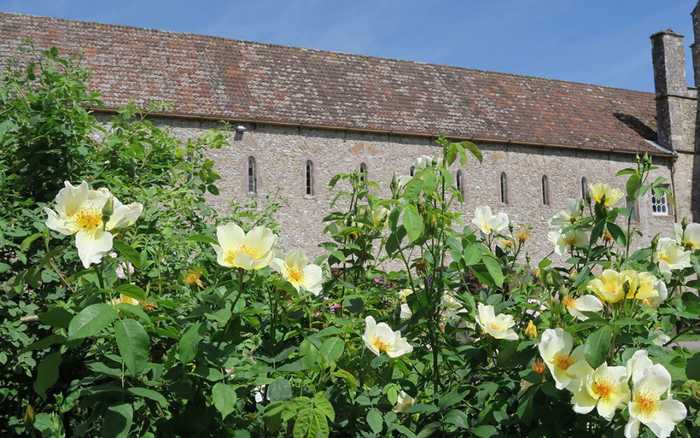How To Prune Your Roses

Nothing creates the vision of an English garden more than a wild rose, tumbling and billowing and generously spirited. Keen to encourage floriferous vigor, Forde Abbey head gardener, Joshua Sparkes bends the stems, gently coaxing them into shapes and patterns. It allows the sun in and for the air to flow freely. It’s an all year round aesthetic. The crafted hoops and arches beautiful, long after the flowers have faded, and the garden is stripped back to its bare bones.
1. The Jack Vass method
When Josh started at Forde Abbey, he bought with him brown paper bags that rattled with seeds, and a knowledge of rose pruning, known as the Jack Vass method. Jack Vass was Vita Sackville-West’s first head gardener back in the 30s. A Wellington navigator in the war, who had been shot down over France. He had managed to escape to Switzerland and then sailed back to England. He became something of an inspiration for rose pruning. Ignoring the conventional wisdom and instead, bending and arching stems to create standalone figurative works or art .
His first attempt was on a briar rose bush leading down to the cottage garden at Sissinghurst. Vita was not a fan. She was a firm believer in leaving roses to go wild. Maybe it was a sweetly scented Summer that convinced her otherwise or a few less rose prickles with newly tethered stems, but Vita was slowly persuaded there was another way.
2. A creative way to prune roses: the general rule of thumb
Jack’s new method took root. Instead of the traditional rose prune of cutting back to three buds and taking out a third, the idea was to arch the stems over in a bend, and tie them in. If it’s a climber, you can’t allow the end of the stem to go below the joint from which it came. If it’s a rambler, you can. Ramblers are more vigorous, the hormones and sap will flow around and upside down, which a climber won’t.
3. The art of snibbling
But first you’ll need to snibble all the flowering growth that’s too short to bend. Usually, this will be the flowering stem from the previous year, that won’t have grown more than a foot. This needs to be cut back to three buds: one for the frost, one for the rain, and one for you. You’ll end up having an older stem with all these three bud cuts across it. Once you’ve done that, you’ll take that older stem, arching it over, and bending it into the shape you want.
4. Uniformity is the key
The longer stems you tie in, making a pattern against the wall. You just have to make sure that each bend is uniform and they are equally spaced. The aim is not to make it look too congested, which the eye can easily pick out. Having it equally spaced and uniform is what makes it look beautiful.
You’re always aiming to take one old stem out, as you want new growth to come from the base. That new growth can grow six or seven foot in a season, and that’s what you’ll tie in next year.
5. Shapes and Patterns
You can have a lot of fun with the aesthetic and the patterns you create, so long as the climbers are uniform and equally spaced. Ramblers, because they’re a lot more vigorous will yield to twirls and bends, with stems shaped into rose balls in the border, or fanned out into spirals that better resemble carpet beaters. There’s a range of columns and carpet beaters in the gardens at Forde Abbey this year, so do follow us on instagram for regular updates on how the roses are coming along. The rose pictured above was photographed before Josh got to work on it, so later in the season there will be a ‘before’ and ‘after’ for comparison.
Newly snibbled ahead of the season, you can follow the garden’s progress on instagram.
Posted on January 21st 2020




